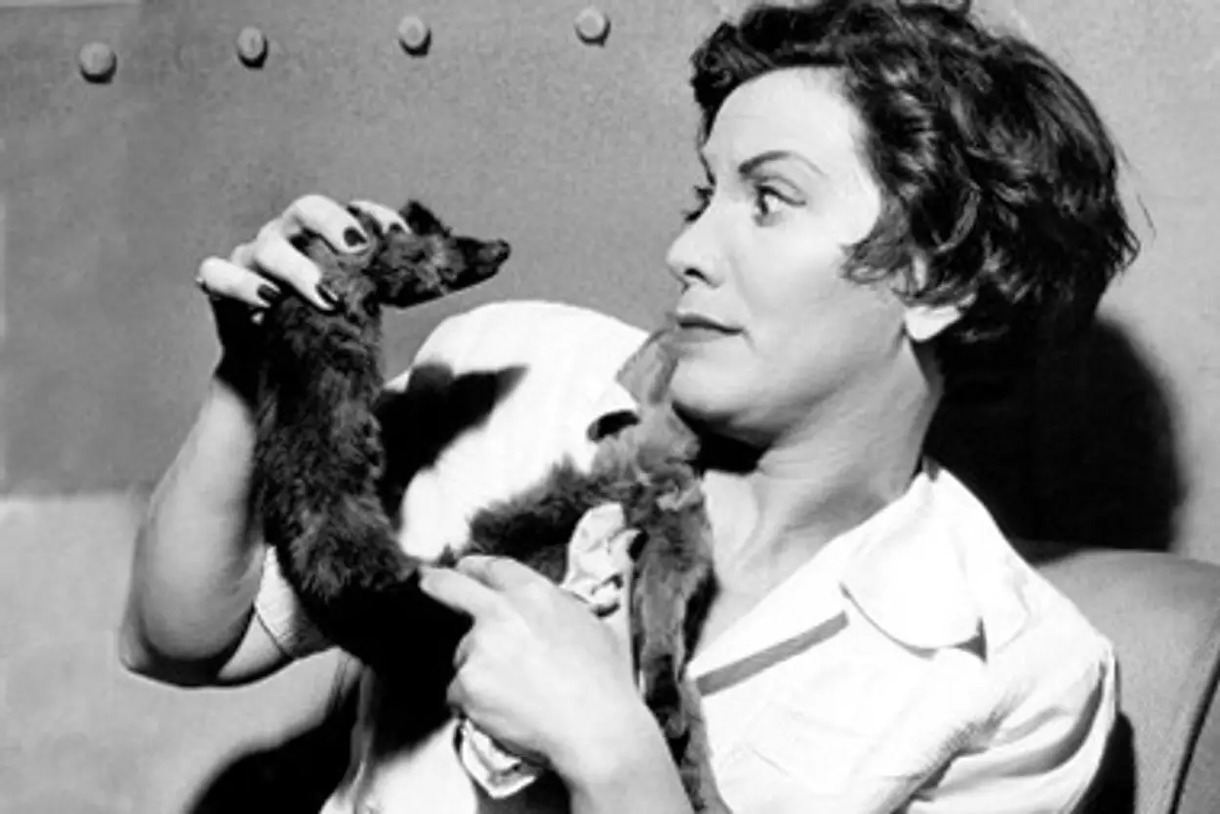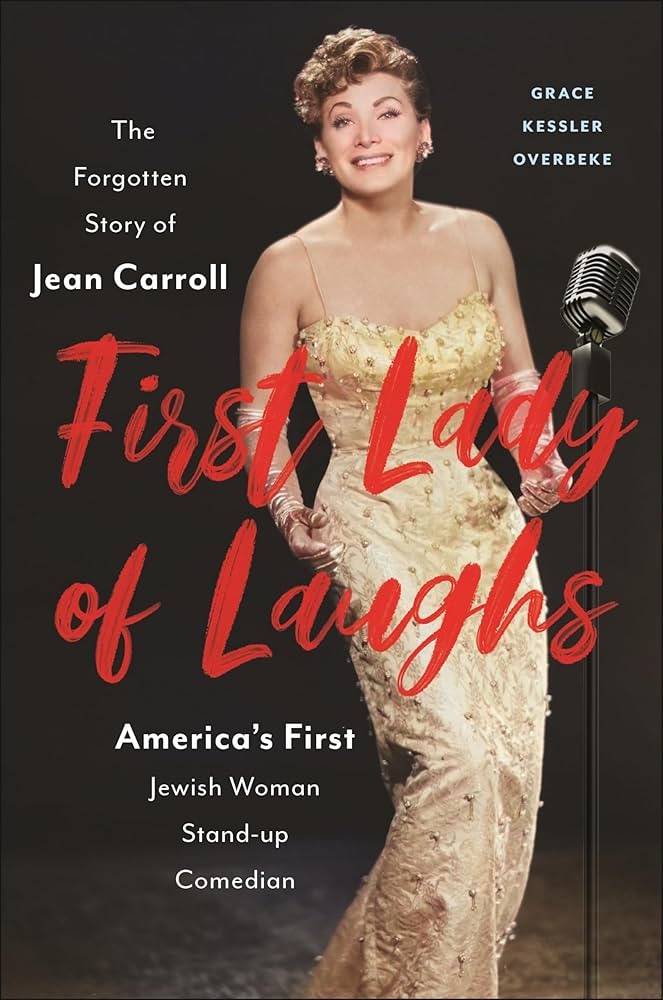Grace Overbeke Explores Comedian Jean Carroll's Life and Career in ‘First Lady of Laughs’
 Jean Carroll in 1953 (Photofest)
Jean Carroll in 1953 (Photofest)Released on September 17, “First Lady of Laughs” by Assistant Professor Grace Kessler Overbeke Ph.D, tells the story of Jean Carroll, the first Jewish woman to become a star in the field we now call stand-up comedy.
Though rarely mentioned among the pantheon of early stand-up comics such as Henny Youngman and Lenny Bruce, Jean Carroll rivaled or even outshone the male counterparts of her heyday, playing more major theaters than any other comedian of her period. In addition to releasing a hit comedy album, Girl in a Hot Steam Bath, and briefly starring in her own sitcom on ABC, she also made twenty-nine appearances on The Ed Sullivan Show.

Carroll made enduring changes to the genre of stand-up comedy, carving space for women and modeling a new form of Jewish femininity with her glamorous, acculturated, but still recognizably Jewish persona. She innovated a newly conversational, intimate style of stand-up, which is now recognized in comics like Joan Rivers, Sarah Silverman, and Tiffany Haddish.
When Carroll was ninety-five, she was honored at the Friars Club in New York City, where celebrities like Joy Behar and Lily Tomlin praised her influence on their craft. But her celebrated career began as an impoverished immigrant child, scrounging for talent show prize money to support her family.
Drawing on archival footage, press clippings, and Jean Carroll’s personal scrapbook, “First Lady of Laughs” restores Jean Carroll’s remarkable story to its rightful place in the lineage of comedy history and Jewish American performance.
Q&A with Grace Kessler Overbeke
What initially inspired you to write a book about Jean Carroll?
Well, my parents are really to blame. They named me after Gracie Allen, a comedian from the 1940's and '50's, and many of my bedtime stories growing up were old comedy records. So it stands to reason that I would become interested in comedy and history. Also, I'm Jewish, so it's not a huge leap for me to be interested in the history of Jewish comedy.
How did Jean Carroll's success as a stand-up comedian influence the trajectory of other female comedians in the industry?
She gave funny little girls someone to emulate! Joan Rivers remembers watching her on Sullivan. Lily Tomlin used to dress up like Jean Carroll, pretending her mother's nightie was an evening gown. Joy Behar, Rita Rudner, Anne Meara, I could go on, they all found inspiration in Jean Carroll.
How was Jean Carroll's style of stand-up comedy was innovative for its time?
I think the main shift—which was not unique to Jean Carroll, but which was certainly clear in her performances—is the move from one-liners to stories rooted in personal experience. Initially, 'stand-up' was a kind of joke recitation—the jokes weren't necessarily rooted in a clear point of view. Jean Carroll's comedy (and what we think of as 'stand-up' today) was quite personal, confessional, and intimate.
How did Jean Carroll's Jewish identity shape her comedic persona and contribute to her cultural impact?
Her Jewish identity was complicated and interesting. On the one hand, she was very proud of being Jewish. She spoke Yiddish at home, she was very involved in Jewish philanthropy, and her life was deeply shaped by the circumstances of being a Jewish immigrant. But on the other hand, she was really invested in conforming to conventional norms of whiteness and femininity, because that was the path she saw to acceptance. Sometimes these things were in tension, and her performances really show that tension. For instance, she always made sure to look as glamorous as possible—perfect hair and makeup, formal gown, etc. And she would talk about upper-middle class "mainstream" American things like PTA meetings and home renovation. But then she would throw in little comments or glances that were coded as Jewish. Some of her reviewers even commented that it's alarming to see someone who looks so sophisticated speaking "Brooklynese."
Can you elaborate on this exceprt? “She modeled a Jewish woman who had assimilated into American upper-middle-class, white, heterosexual, attractive, and even glamorous, society. At the same time, her persona retained something markedly Jewish to those who knew how to discern it. She had a subversive quality—not Lenny Bruce subversive but something more subtle—that nonetheless sparked inspiration among her fans.”
Sometimes, the same performance can mean different things to different audience members, depending on who they are and what they know. For instance, the color lime green might conjure "Brat Summer" for a Gen-Z viewer, and "Slimer" for a die-hard Ghostbusters fan. So too with all cultural references. For instance, Jean Carroll might do a comedy bit where she portrays a mother aggressively foisting food on her child. Some audience members may laugh at the mother for being so desperate and 'extra.' But some other audience members may be laughing with recognition—thinking, "Yes, my mother is like that!" And some audience members (probably Jewish or other immigrant populations) would recognize that the 'force-feeding mother' is a long-standing trope in Jewish comedy. Jean Carroll was invoking the 'force-feeding mother' stereotype as a way of signaling to Jewish audience members, "I am one of you," without actually having to explicitly say the word 'Jewish' and risk alienating audience members. And it wasn't just stereotypes--she used other signals like shrugs, syntax, etc. There were lots of codes for those who knew enough to read them.
What were the most challenging or rewarding aspects of researching Jean Carroll's life and career through archival materials?
Archival research is full of twists and turns. You're trying to put together a story from the literary detritus of a person's life, and it can lead you down strange paths. For example, I learned that there was a burlesque dancer who also went by the stage name "Jean Carroll," (to say nothing of the contemporary figure E. Jean Carroll), so making sure that I was following newspaper clippings from the correct "Jean Carroll" was a challenge.
Did you develop a personal connection with Jean Carroll through your research, and if so, how did that influence your writing?
Oh my dear, yes! There's a passage in the beginning of the book where I talk at some length about my anxieties surrounding doing justice to her story. It was really important to me to try and communicate her voice clearly. So that involves everything from being very intentional about punctuation and line spacing to developing vivid descriptions and setting the scene.
What was the writing process like for "First Lady of Laughs," and were there any challenges or surprises you encountered?
The research and writing process was spread out over many years, but I would say that much of it could be described as 'nocturnal.' Surprisingly, I also found that a lot of the best interviews or research finds happened by following a lead from a friend of a friend or a newspaper footnote—it felt a bit like detective work in that respect.
Who do you hope to reach with this book?
One of the challenges of my current project is that I am trying to reach a lot of different people: academics, Jewish mothers in book clubs, Taylor Swift, theatre makers, comedy nerds, history buffs, my high school crush, my students, my coworkers, my grandmother, my editor, my doctoral advisor, my little sister, my tenure committee, my in-laws and extended family, Jean Carroll and her family, the holy trinity of TV writers (Josh Malmuth, Jessi Klein, Julie Klausner), YA bookworm girls, Sarah Silverman, working women, moms, working moms, Baby Boomers, indoor kids, early 2000's celebrities, Jews, people who are afraid to say the word ‘Jews,’ people who buy books they don’t read, people who read books they don’t buy, un-pretty women, people who like women, Henry Bial, fans of The Marvelous Mrs. Maisel, PhD candidates, my husband, Haim, and Emmy Blotnick. For starters...
How do you believe your book will contribute to the ongoing conversation about the history of comedy and the role of women in the industry?
I think this book is a good example of the great stories that get omitted from history by overlooking women, people of color, disabled people, and other people from marginalized groups. My hope is that it will inspire people to explore the nooks and crannies of history to unearth more of these stories.
What are your predictions for the future of comedy and the role of women in the industry?
I'm not great at trend forecasting. I deal more in the past than the future, but I certainly hope that women thrive in comedy (and every other field). My comedy students make it clear that there's a lot of room for growth in terms of gender equity in the industry, so I hope that we see some big strides made there.
Do you incorporate your research on Jean Carroll into your teaching at Columbia?
I don't teach directly about Jean Carroll, but I do tell all my students a lesson that I've learned from her: Your point of view is your secret weapon.
Recent News
- Students Launch “In Flux,” an Interactive Digital Magazine
- Top Stories from Columbia College Chicago in 2024
- The Dance Center Presents the Chicago Solo Spotlight Festival, March 13-15
- Columbia College Chicago Team Wins National NRF Retail Challenge
- Alumni and Faculty Shine in Newcity Stage’s 'Players 2025'